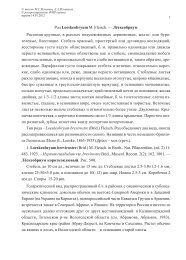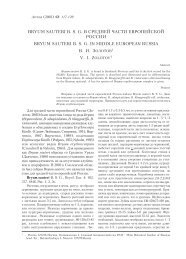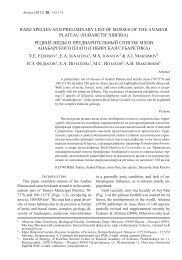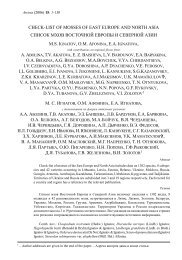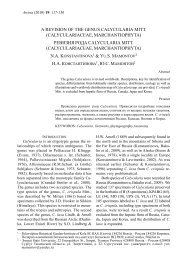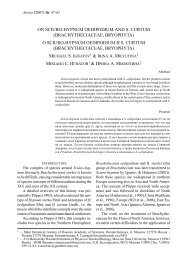THE GENUS BRYUM (BRYACEAE, MUSCI) IN MIDDLE ... - Arctoa
THE GENUS BRYUM (BRYACEAE, MUSCI) IN MIDDLE ... - Arctoa
THE GENUS BRYUM (BRYACEAE, MUSCI) IN MIDDLE ... - Arctoa
You also want an ePaper? Increase the reach of your titles
YUMPU automatically turns print PDFs into web optimized ePapers that Google loves.
188<br />
rose, in upper leaf longly rhomboid-hexagonal<br />
to longly rhomboid, 40-60 x 12-16 μm, in midleaf<br />
rhomboid, elongate-rhomboid, elongate-hexagonal,<br />
more rarely rectangular, 40-60 x 16-24<br />
μm, towards margin narrower, more elongate,<br />
below rectangular, to 100 x 25 μm.<br />
Perichaetial leaves triangular-lanceolate,<br />
margin plane, costa ending below leaf apex to<br />
shortly excurrent. Seta (1-)2(-4) cm, reddish,<br />
rigid, not or waekly twisted when dry, below<br />
capsule shortly and strongly curved. Capsule<br />
inclined to pendulous, light-fuscous to brown,<br />
before dehiscence to 3.0 mm long, 1.5 mm thick,<br />
broadly pyriform, symmetric, strongly contracted<br />
below broad mouth when dry; neck as long<br />
as urn or shorter, collapsing when dry. Operculum<br />
convex, with small beak, brown, slightly<br />
glossy. Annulus 3-4-rowed. Peristome attached<br />
at mouth, 440-600 μm long. Exostome teeth at<br />
base 100-140 μm wide, gradually acuminate,<br />
below brownish-yellow, uppermost part stout,<br />
hyaline; border 4-8 μm wide; median line zigzag-shaped;<br />
fundus of the same color as teeth<br />
or brighter, 50-70 μm high; ventral trabeculae<br />
to 30. Endostome free, yellowish, basal membrane<br />
ca. 1/2 of endostome length; segments broad,<br />
half-segment at base 40-52 μm wide, broadly<br />
perforate below, narrowly split above; cilia 2-3,<br />
long, densely papillose, appendiculate. Spores<br />
(14-)16-20 μm, fuscous-yellow.<br />
Differentiation: This species is polymorphous<br />
and most collections consist of sterile plants. When<br />
growing in sunny habitats, B. turbinatum is low,<br />
1-2 cm high, and forms dirty-olive-green to pinkish<br />
tufts, similar in color to B. pallens, but the<br />
former is immediately differentiated by unbordered<br />
leaves (in B. pallens, the border is always clear<br />
and bistratose). Plants of B. turbinatum from shady<br />
habitats are taller, 2-3(-4) cm high, pale, and resemble<br />
weak phenotypes of B. pseudotriquetrum.<br />
Such plants of B. turbinatum can be recognized<br />
by non-decurrent leaves and a 2-3-row border (vs.<br />
a 3-5(-6) row border in B. pseudotriquetrum).<br />
When sporophytes are present, the shape of the capsule<br />
is distinct; strongly contracted below the mouth,<br />
and relatively short.<br />
Habitat: On wet and moist, sandy to clayish<br />
soil, sometimes among loose herbaceous vegetation;<br />
V. I. ZOLOTOV<br />
in wet meadows, river banks, along streams, edges<br />
of mires, at springs, on partly submerged sandstones.<br />
Selected specimens examined (20): Bashkortostan,<br />
Selivanova-Gorodkova # 231, LE; Lipezk Prov., Popova<br />
7.VI.1986, VOR; Nizhnij Novgorod Prov., Shvezov #157,<br />
LE; Tula Prov., Barkov 3.VI.1897, LE; Voronezh Prov.,<br />
Popova 5.VI.1981, LE.<br />
Bryum schleicheri Schwaegr., Sp. Musc.<br />
Frond., Suppl. 1, 2: 113. pl. 73. 1816. Fig. 80<br />
Bryum latifolium (Schwaegr.) Brid., Musc.<br />
Recent. Suppl. 4: 120. 1819(1818). – Mnium latifolium<br />
Schwaegr., Sp. Musc. Frond. Suppl. 1, 2:<br />
138. 1816. – B. schleicheri var. latifolium (Schwaegr.)<br />
Schimp., Syn. Musc. Eur. (ed.2) 463. 1876.<br />
Dioicous; only female plants found in the<br />
study area; [perigonia wide, with numerous purple<br />
anteridia and fuscous paraphyses; paraphyses<br />
twice as long as antheridia; perigonial leaves<br />
cordate, with brownish costa and plane margin].<br />
Plants in compact, easily separating tufts to<br />
3.5-6.0 cm high, greenish-stramineous; rhizoid<br />
tomentum weak, rhizoids fuscous, finely papillose.<br />
Stem stout, light-brownish, yellowish to<br />
orangish, 2.0-6.0 cm long, evenly densely foliate,<br />
not comose; subterminal shoots absent or 1,<br />
foliage pattern similar to that of stem. Leaves<br />
of sterile shoots 2.5-3.5 mm long, 1.3-1.7(-2.5)<br />
mm wide. Stem leaves appresed to erect when<br />
wet, flexuose to slightly contorted when dry,<br />
3.0-4.0(-4.5) mm long, 2.0-2.5 mm wide, broadly<br />
ovate to cordate, widest at 1/4-5/7 of leaf<br />
length, shortly acute, +cucullate, carinate, nondecurrent,<br />
at base green to brownish; margin<br />
plane, weakly serrulate above; border 4-5-rowed,<br />
unistratose; costa stout, decurrent, at base brownish,<br />
above yellow-green, percurrent to shortly<br />
excurrent. Laminal cells with slightly incrassate<br />
cell-walls, in upper leaf rhombic, 44-60 x<br />
24-36 μm, in mid-leaf rhomboid-hexagonal, 80-<br />
92 x 28-32(-40) μm, at base rectangular, large,<br />
to 40 μm wide, in leaf corners subquadrate, ca.<br />
40 μm wide.<br />
[Perichaetial leaves oblong-lanceolate, margin<br />
plane, costa strong, percurrent. Seta to 3-4 cm<br />
long, red, slender, slightly twisted when dry,<br />
abruptly curved below capsule. Capsule inclined,<br />
yellowish-fuscous, orange below mouth, 3.5 mm<br />
long, 1.5 mm thick, broadly pyriform, symmetric,<br />
strongly contracted below broad mouth when<br />
Fig. 80. Bryum schleicheri Schwaegr. (2-5 from Komi Republic, Abramova 412, LE; 1 & 6-13 from Tver province,<br />
Notov, MW): 1 – habit; 2, 9-13 – leaves; 3 – upper laminal cells; 4 – mid-leaf cells; 5 – basal cells; 6-8 – leaves from<br />
upper stem. Scale bars: 5 mm for 1; 1 mm – 2, 6-13; 200 μm – 3-5.



